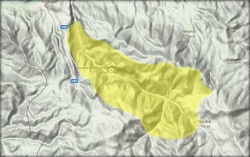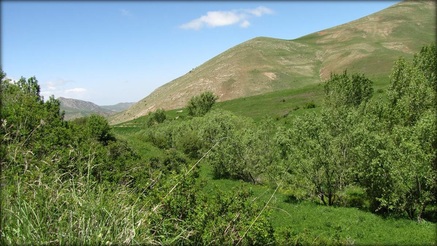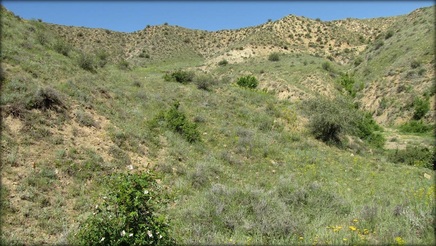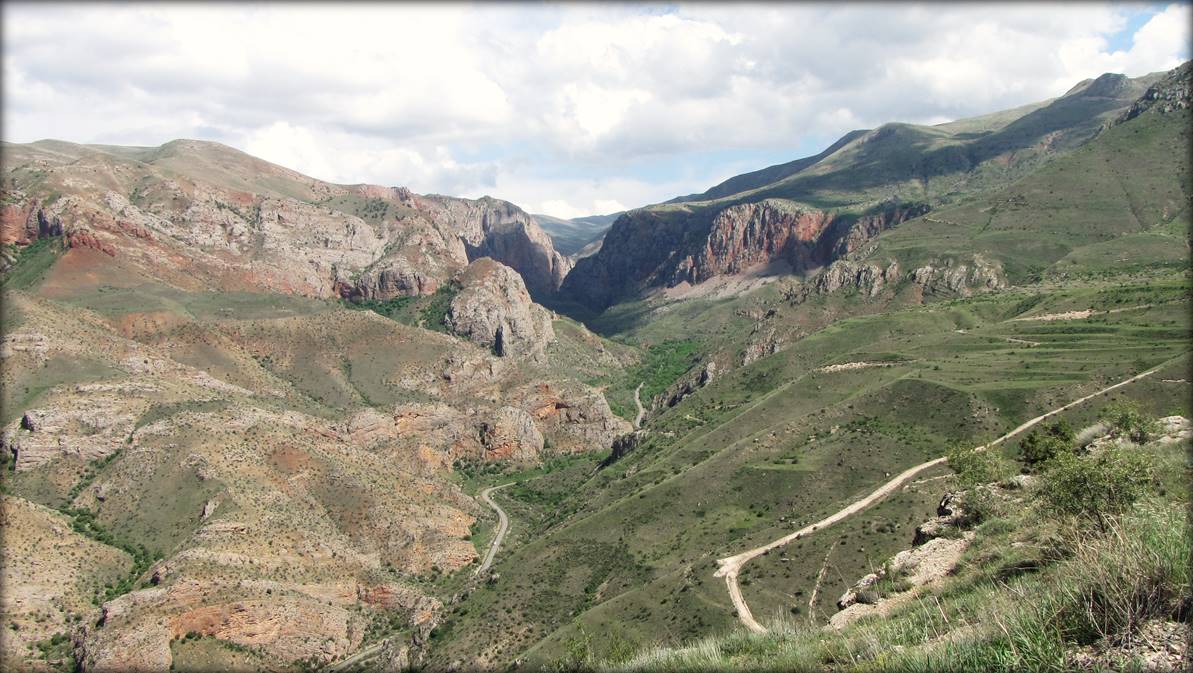|
General description:
The area (about 3,840 ha) is located at the north-eastern slopes of Hayotsdzor mountain ridge at elevations from 1200 to 2320 m above sea level. The average steepness of slopes is from 10˚ to 25˚. The area is cut by deep rocky canyon; from the lower part to upper the habitats change significantly, and include variegated semideserts, tragacanth and sainfoin mountain steppe, elements of meadows, riparian forest. broad-leafed forest and alpine grasslands. Dominant vegetation among herbs are various grasses (Poa sp. Festuca sp. etc), and especially wide variety of legumes (Astragallus sp., Onobrychis sp, Trifolium sp., etc.); among bushes are tragacanths, sainfoin (Onobrychis cornuta), rosehip (Rosa sp.), hawthorn (Crataegus sp.), honeysuckle (Lonicera sp.), and others; among trees are poplar (Populus sp.). The area is characterized by relatively dry climate with short rainy seasons. Description of butterfly diversity: Number of butterfly species in the area – 163 (72% of total number of species in Armenia). Two of the species included in IUCN Red List, 12 species included in European Red List, 14 species included in National Red Data Book. The species of national and international concern are: Carcharodus lavatherae, Parnassius mnemosyne, Parnassius apollo, Papilio alexanor, Zegris eupheme, Colias aurorina, Colias chlorocoma, Tomares romanovi, Pseudophilotes vicrama, Maculinea arion, Maculinea alcon, Aricia anteros, Polyommatus dorylas, Polyommatus damon, Polyommatus eriwanensis, Polyommatus surakovi, Polyommatus huberti, Polyommatus ninae, Polyommatus turcicus, Polyommatus iphigenia, Pseudochazara schahrudensis, Hipparchia statilinus, Chazara briseis, Brethis ino, Mellicta aurelia. Threats: The major threats for the area are related to overgrazing and mowing, also since the area is widely used for picnic, there is a high risk of fire, which comes from non-careful behavior. The area is managed mainly with the community Gnisheek, with the livestock husbandry as the major income source. Therefore the area serves for grazing and haymaking. The livestock (mainly cattle, sheep, and goats in a less extent) is grazing here from April till September. Intensive grazing might cause significant decrease or even removal of host-plants of key species, and especially destruction of productive top-soil layer at the slopes by feet of livestock. Mowing that was transferred into automatic - removes significant portion of the host-plants at flatter areas in the time of larval development or egg-laying. The mentioned threats negatively influence mostly species that develop on herbs. The following species are suspected to be affected by over-exploitation of the area: Carcharodus lavatherae, Parnassius mnemosyne, Zegris eupheme, Tomares romanovi, Pseudophilotes vicrama, Pseudophilotes bavius, Maculinea arion, Maculinea alcon, Ultraaricia crassipuncta, Polyommatus dorylas, Polyommatus damon, Polyommatus eriwanensis, Polyommatus surakovi, Polyommatus huberti, Polyommatus ninae, Polyommatus turcicus, Polyommatus iphigenia, Pseudochazara schahrudensis, Hipparchia statilinus, Chazara briseis, Brethis ino, Mellicta aurelia. Among the mentioned species the population of Pseudophilotes bavius is of special concern, since it is the only known population of the species living in Armenia. To secure conservation of the area it is important to strengthen the protection regime and to manage grazing and mowing on a sustainable level. To increase financial sustainability of the local community it is important to use the potential of tourists and to support development of ecotourism in the area. In 2015-2016 the negotiations with the Gnishik Intercommunity Fund lead to development of infrastructure for butterfly-watching in two communities: Gnishik and Areni. In frames of that three butterfly-watching trails: Amaghou steppe, Noravank semi-desert, and Gnishik steppe have been developed. The area is also included in Key Birding Sites of Armenia. The work on assessment of the PBA Gnishik is supported by Rufford Foundation, while the work on development of butterfly-watching in this area is supported by GEF / UNDP Small Grant Program. |
|
© BirdLinks Armenia NGO, 2014
Charity Registration Number 03A968527
Charity Registration Number 03A968527






